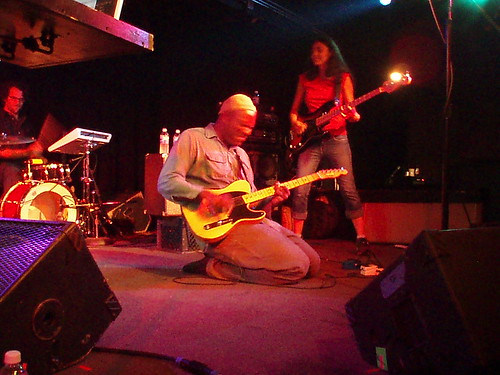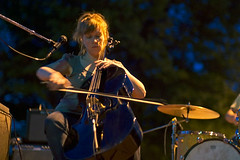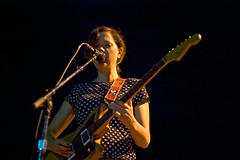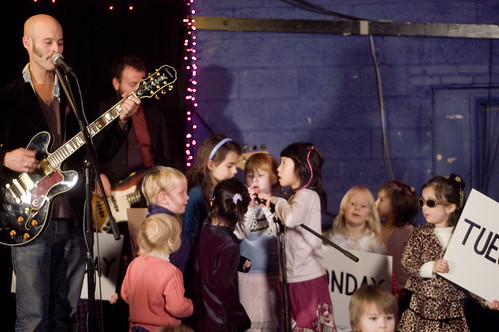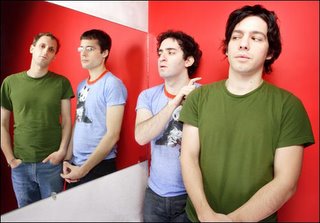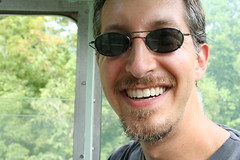at Birchmere, 9/15/2006
The review in the Post (quoted below) covers the basics... The show was excellent. This guy has really found his voice, and is at the top of his game. He's got crazy skills with the fingerpicking guitar. He's a great singer. Not bad at the electric piano either. He's not much for banter and chatting between songs. The set was pretty much all business - just blowing through the songs with hardly enough time for his band to keep up. And they nailed it. Each song really came to life perfectly - the uptempo ones totally rocked, but with nice subtle touches which also transferred to the slower material.
There was much instrument swapping. Band consisted of M.Ward plus two guitarists who switched often among acoustic guitar, electric guitar, and electric bass, plus two drummers - one female who also did backing vocals, and one male who spent about half the show at the vibraphone, and half behind a drum kit (and one song at the piano). Funny, another band with two drummers... used very effectively, they did quite a bit of unison playing, but really for emphasis. At one point, a quick stream of steady 16th notes doubled by both drummers added a cool sounding layer of strange high harmonics.
One of the encores began with M.Ward solo, doing "I'll Be Yr Bird." Gorgeous. He changed the lyrics at one point - from "I'm not your chestnut, I'm not your mole" to "I'm no Vic Chestnutt, I'm no Bob Mould." A few of us old folks in the audience chuckled, and hopefully picked up on that as a local reference. The crowd was really quite strange - young, old, everywhere inbetween.
There are many reasons to dislike the Birchmere, and I'm happy to go on about many of them. For now, let's just complain about $5 for a 10oz. solo cup of beer. On the other hand, they have Shiner on tap. Mmmm. Also, sound was quite good and we got there a bit late, but still were able to get a spot right up front where we could see (and hear) very well.
If you don't know about M. Ward, you can watch the video of "Chinese Translation" on YouTube. And/or download the title track of his new album, Post-War, at Salon.com's "Audiofile."
From the Washington Post, Monday, September 18, 2006; C05Shortly after M. Ward played "A Voice at the End of the Line" and "Poor Boy, Minor Key" at the Birchmere on Friday night, it seemed he longed to be a soft-rock troubadour. Then, back-to-back Daniel Johnston covers indicated he was bent on embracing the eccentric singer-songwriter model. Later, as he waved his band into a galloping trifecta ("Right in the Head," "Flaming Heart," "Four Hours in Washington") of indie rock, he sounded as if he could be the savior of that musty genre. But unlike the Ward of, say, five years ago, this hour-long set was far more than just a series of clever genre-hopping tricks: It was cohesive and stirring in the manner of an artist whose vision has crystallized.
Ward's artistic maturation isn't readily apparent on his discs; this year's "Post-War" is only sporadically excellent. But supported as he was Friday by a sympathetic band (a percussion-centric quartet featuring two drum kits) in a judicious investigation of his back catalogue, his live show was revelatory. His song structures suddenly made sense -- an aesthetic that equally values John Fahey, Fleetwood Mac and Sonic Youth. His voice buzzed uniquely -- an oddly rousing paste of John Fogerty and Popeye. And though the show wasn't perfect -- "Post-War's" title track was sluggish, and taking a second encore was unnecessary -- it was close enough to warrant a serious escalation in Ward's musical standing.
-- Patrick Foster
